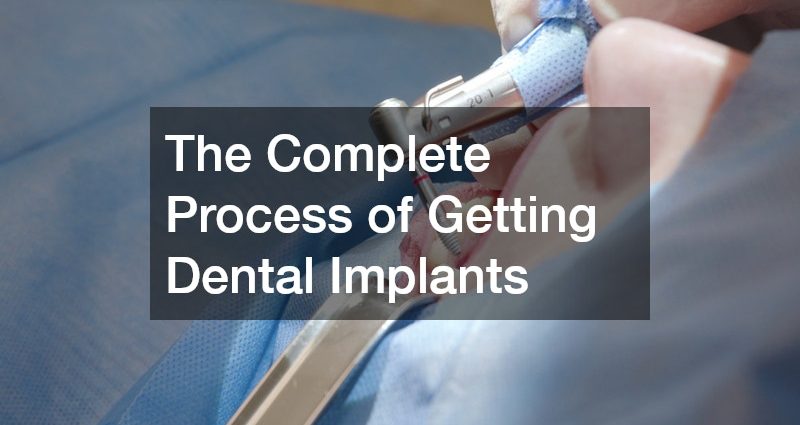
Getting dental implants is a life-changing decision for those looking to restore missing teeth with a natural-looking and durable solution. While the process may seem complex, understanding each stage—from consultation to recovery—can help you feel confident and prepared. This comprehensive guide breaks down every step of the dental implant journey, providing the information you need to make an informed decision about this transformative procedure.
What Are Dental Implants?
Definition and Purpose
Dental implants are artificial tooth roots, typically made of titanium, that are surgically placed into the jawbone. They serve as a stable foundation for replacement teeth such as crowns, bridges, or dentures.
Unlike traditional tooth replacement options, dental implants mimic the function of natural teeth, preserving bone structure and providing superior stability.
Types of Dental Implants
There are two main types of dental implants:
-
Endosteal Implants: Placed directly into the jawbone and used in most cases due to their strong support and long-term success.
-
Subperiosteal Implants: Positioned on top of the jawbone under the gum tissue, these are used when bone height or density is insufficient.
Components of a Dental Implant
Each dental implant consists of three essential parts:
-
Implant Post: The titanium or ceramic screw that integrates with the jawbone.
-
Abutment: A connector piece that attaches the crown to the implant post.
-
Crown: The visible, custom-made artificial tooth that completes the restoration.
Benefits of Dental Implants
-
Look, feel, and function like natural teeth
-
Prevent bone loss and preserve facial structure
-
Offer long-lasting durability and stability
-
Eliminate the need for adhesives or special maintenance
-
Improve speech, chewing, and overall confidence
Risks and Considerations
As with any surgical procedure, dental implants carry some risks, including infection, nerve injury, or implant failure. However, with proper planning and care, the success rate of dental implants is over 95%.
Who Is a Candidate for Dental Implants?
Eligibility Requirements
Ideal candidates have healthy gums, sufficient bone structure, and good overall oral hygiene. Commitment to maintaining oral health post-surgery is crucial for long-term success.
Bone Density Considerations
A strong and healthy jawbone is essential for implant placement. If bone loss has occurred, procedures like bone grafting or sinus lifts may be necessary before implant surgery.
Age and Dental Implants
While there is no upper age limit for dental implants, candidates under 18 are generally advised to wait until jaw growth is complete.
Medical Conditions and Dental Implants
Certain health issues—such as uncontrolled diabetes, immune disorders, or heavy smoking—can affect healing and implant success. A thorough medical evaluation ensures safety and suitability for the procedure.
Consultation and Evaluation Process
During your consultation, the dentist performs a comprehensive examination, including X-rays and 3D imaging, to assess bone health and plan your personalized treatment.
What Is the Procedure for Getting Dental Implants?
Preparation and Planning
Before surgery, your dentist develops a detailed treatment plan tailored to your needs. This may involve digital imaging, impressions, and preliminary treatments like tooth extraction or bone grafting.
Surgical Process
On the day of surgery, local anesthesia or sedation ensures comfort. The dentist makes a small incision in the gum, drills a precise hole in the jawbone, and inserts the implant post. The gum is then closed over the implant while healing begins.
Healing and Osseointegration
Over the next few months, a natural process called osseointegration occurs, during which the implant fuses with the jawbone. This creates a strong and permanent foundation for your replacement tooth.
Placement of Abutment
Once healing is complete, a minor procedure is performed to attach the abutment—the part that connects the implant to the crown.
Final Restoration
The last step involves placing a custom-made crown that matches your natural teeth in shape, size, and color, completing your smile restoration.
How Long Does the Dental Implant Process Take?
Initial Consultation to Surgery
The process begins with diagnostic exams and treatment planning. Depending on your oral health, this stage can take several weeks.
Phase of Healing
Osseointegration typically takes three to six months, depending on the individual’s healing capacity and bone quality.
Placing the Abutment
The abutment is usually placed once the implant has fully bonded with the bone, often after a few months.
Crown Attachment Timing
After the gums have healed around the abutment, the crown is attached, finalizing the implant.
Total Duration and Variabilities
From start to finish, the dental implant process generally spans four to nine months, depending on healing times, bone health, and the need for additional procedures.
How Much Do Dental Implants Cost?
Cost Components
The total cost includes consultation fees, imaging, implant placement, abutment installation, and the crown. Additional costs may apply for bone grafting or extractions.
Geographical Cost Variances
Prices for dental implants vary depending on your location and the dentist’s expertise. Urban areas often have higher costs due to overhead and demand.
Insurance Coverage
Some insurance plans cover portions of the implant process, especially related to crowns or bone grafting. Patients should review their plans carefully or seek pre-authorization.
Financing and Payment Plans
Many dental offices offer financing options or third-party payment plans to make implants more affordable.
Tips for Managing Costs
-
Compare treatment quotes from multiple providers
-
Explore flexible payment options
-
Maintain good oral hygiene to avoid additional procedures
-
Use health savings accounts (HSAs) or flexible spending accounts (FSAs) if available
Choosing to get dental implants is an investment in both your oral health and confidence. By understanding the process—from consultation and planning to surgery and restoration—you can set realistic expectations and prepare for long-term success. With proper care, dental implants can last a lifetime, offering a permanent, comfortable, and natural-looking solution for missing teeth.


